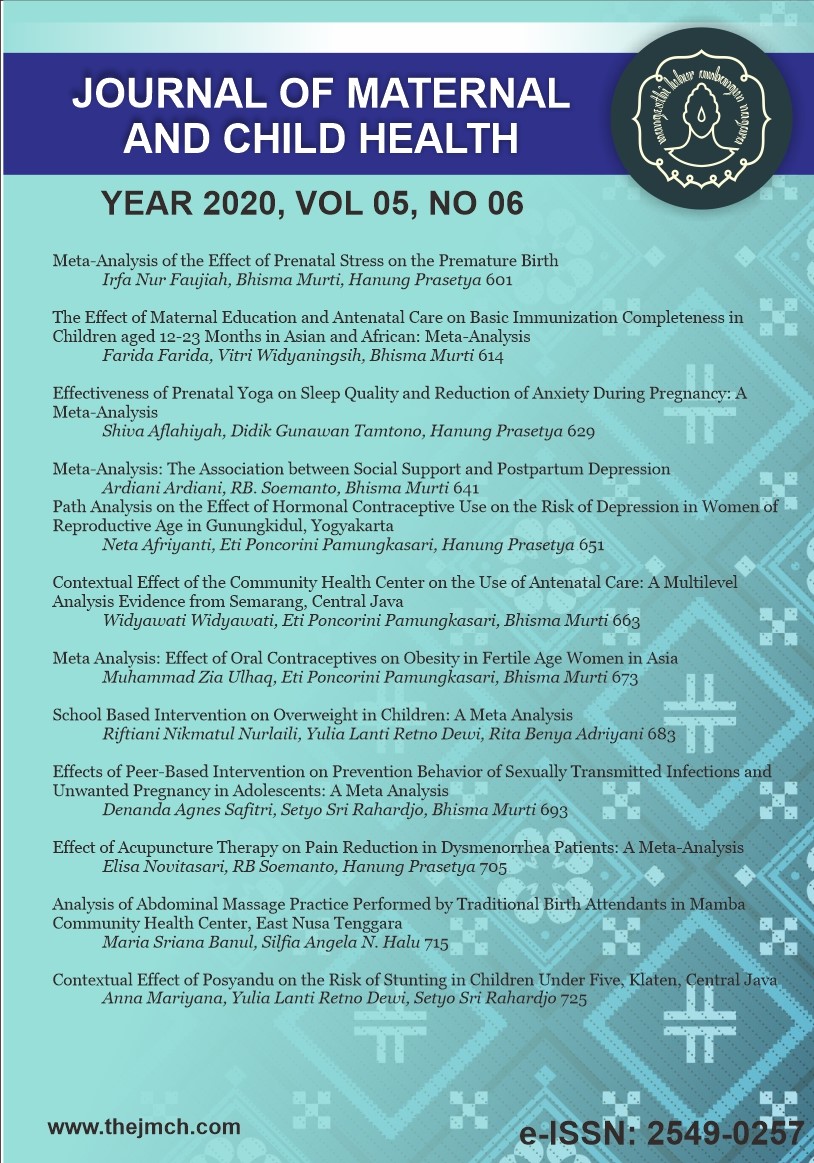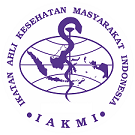Contextual Effect of the Community Health Center on the Use of Antenatal Care: A Multilevel Analysis Evidence from Semarang, Central Java
Abstract
Background:
References
Agampodi TC, Rheinl
Aritonang DVA, Adiwijaya S, Wulandari A, Anita N (2019). Related knowledge and support family mother pregnant women attitudes about prenatal care (ANC). BirEx Journal, 1(3): 28
Boah M, Mahama AB, Ayamga EA (2018). They receive antenatal care in health facilities, yet do not deliver there: pre-dicors of health facility delivery by women in rural Ghana. BMC Pregnancy Childbirth. 1
Desta M, Kassie B, Chanie H, Mulugeta H, Yirga T, Temesgen H, et al. (2019). Adherence of iron and folic acid supple-mentation and determinants among pregnant women in Ethiopia: A syste-matic review and meta-analysis. Re-prod Health, 16(1): 1
Dinas kesehatan Kabupaten Semarang (2019). Profil kesehatan kabupaten Semarang.
Dinas Kesehatan Provinsi Jawa Tengah (2017). Profil kesehatan provinsi jawa tengah.
Dowswell T, Carroli G, Duley L, Gates S, G
Ewunetie AA, Munea AM, Meselu BT, Sime-neh MM, Meteku BT (2018). Delay on first antenatal care visit and its associated factors among pregnant women in public health facilities of Debre Mar-kos town, North West Ethiopia. BMC Pregnancy Childbirth, 18(1): 1
Fekadu GA, Ambaw F, Kidanie SA (2019). Facility delivery and postnatal care ser-vices use among mothers who attended four or more antenatal care visits in Ethiopia: further analysis of the 2016 demographic and health survey. BMC Pregnancy Childbirth, 19: 64. doi: 10.1186/s12884-019-2216-8.
Haddad GS, DeJong J, Terreri N, Perin, Vaz L, Newby H, et al. (2016). Patterns and determinants of antenatal care utiliza-tion: Analysis of national survey data in seven countdown countries. J Glob Health. 6(1). doi: 10.7189/jogh.06.01-0404.
Hanifah A, Pratomo H, Hoang G (2018). Husband
Izadirad H, Niknami S, Zareban I, Hidarnia A (2017). Effects of social support and self-efficacy on maternal prenatal cares among the first-time pregnant women, Iranshahr. J Family Reprod Health, 11(2): 67
Kahsay ZH, Hiluf MK, Shamie R, Tadesse Y, Bazzano AN (2019). Pregnant women
Kaswa R, Rupesinghe GFD, Longo-Mbenza B (2018). Exploring the pregnant women
Motlagh ME, Torkestani F, Amiri HA, Rabiee SM, Radpooyan L, Shirvani SDN, et al. (2017). Iranian husbands
Murti, B. (2018) Prinsip dan metode riset epidemiologi edisi keempat. Surakarta: Universitas Sebelas Maret.
Nyfl
Ogu R. dan Alegbeleye JO. (2018). Improving maternal health:Women
Paul P., Zaveri A., Chouhan P. (2019). Asse-ssing the impact of antenatal care utili-zation on low birthweight in India: Analysis of the 2015
Permenkes (2016). Peraturan Menteri Kese-hatan no. 44 tahun 2016.
Rehg PA., Krauss MJ., Spitznagel EL., Bom-marito K., Madden T., Olsen MA. et al. (2016). Maternal age and risk of labor and delivery complications. Matern Child Health J, 19(6): 1202
Saptarini I dan Suparmi (2016). Antenatal care service utilization and complete-ness in Kebon Kalapa Village , Bogor City. Buletin Penelitian Kesehatan, 3(4): 6
Shahry P, Kalhori SRN, Esfandiyari A (2016). A comparative study of perceived social support and self-efficacy among women with wanted and unwanted pregnancy original article. Int J Community Based Nurs Midwifery, 4(2): 176
Sinyange N, Sitali L, Jacobs C, Musonda P, Michelo C (2016). Factors associated with late antenatal care booking: po-pulation based observations from the 2007 Zambia demographic and health survey. Pan Afr. med, 25: 109. doi: 10.-11604/pamj.2016.25.109.6873.
Sulaeman ES (2016). Promosi kesehatan: teori dan implementasi di Indonesia.
Tasliah, Widagdo L., Nugraha P. (2017). Faktor-faktor yang berhubungan dengan kunjungan antenatal care(anc) padaibu hamil di wilayah kerja Puskesmas Candilamakota Semarang. Jurnal Ke-sehatan Masyarakat (e-Journal), 5(3): 637
Tekelab T, Chojenta C, Smith R, Loxton D (2019). Factors affecting utilization of antenatal care in Ethiopia: A systematic review and meta- analysis. Plos ONE, 14(4): e0214848.. https://dx.doi.org/-10.1371%2Fjournal.pone.0214848.
Tesfaye G, Loxton D, Chojenta C, Semahegn A, Smith R (2017). Delayed initiation of antenatal care and associated factors in Ethiopia: A systematic review and meta-analysis. Reprod Health, 14: 150. doi: 10.1186/s12978-017-04124.
Tsai Y, Hsu Y, Hou T, Chang CH (2018). Effects of a web-based antenatal care system on maternal stress and self-efficacy during pregnancy: A study in Taiwan. J Midwifery Wom Heal, 63(2): 205
Uldbjerg CS, Schramma S, Kaducub FO, Ovugac E, Sodemanna M (2020). Per-ceived barriers to utilization of ante-natal care services in northern Uganda: A qualitative study. Sex Reprod Health, 23: 100464. doi: 10.1016/j.srhc.2019.1-00464.
Warri D, George A (2020). Perceptions of pregnant women of reasons for late initiation of antenatal care: A qualita-tive interview study. BMC Pregnancy Childbirth, 0: 1
Zhou C, Zheng W, Yuan Q, Zhang B, Chen H, Wang W, et al. (2018). Associations between social capital and maternal depression: Results from a follow-up study in China. BMC Pregnancy Child-birth. 18(1): 1





